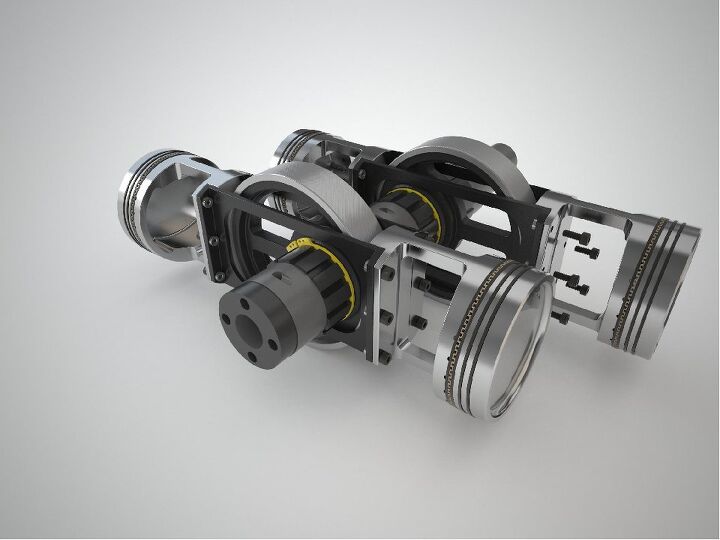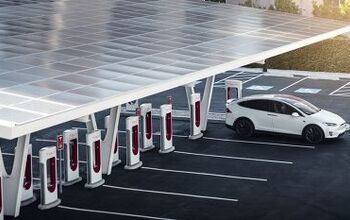The New Waissi Engine, Pistons But No Connecting Rods

Though much of the attention paid to new automotive drivetrains recently has focused on hybrids and battery electric vehicles, the simple fact is that internal combustion engines are going to be around for a while. They’re still teaching the old dog a few tricks and even coming up with a new breed or two as can be seen every year at the Society of Automotive Engineers World Congress, in Detroit’s Cobo Hall. There is always at least a handful of inventors and promoters at the SAE confab showing off their new engine designs. Maybe it’s the romantic idea of a lone inventor trying to prove his concept in the face of a skeptical world, but after looking over the convention program, the booth that I most wanted to visit was that for the Waissi Engine, the invention of Gary Waissi, an engineering professor at Arizona State University.
Note: The SAE World Congress was in April. Publication was delayed while I corresponded with Professor Waissi and clarified some questions about his engine.
Waissi’s new engine is an opposed piston configuration that uses conventional head, valve and combustion chamber designs. What’s different is that the Waissi engine has no connecting rods between the pistons and the crankshaft. Instead, the pistons push directly on what Waissi calls a “crankdisk”. The engine’s output shaft has a large journal mounted eccentrically on the shaft, with a bearing ring that spins on the journal. The outside surface of the bearing ring fits into a landed grove at the bottom of the piston structure. When the piston is pushed down during the power stroke, the downward motion of the piston causes the crank to spin because of the offset as the bearing ring rolls under the piston landing. Each piston has an opposed twin which then spins the crank disk another 180 degrees to complete a revolution. The two pistons are attached to each other via steel rods, which keeps them timed properly. In his latest design, Waissi has replaced the rods with solid plates.
Waissi’s latest design, which will be the basis for the prototype that hopefully runs. Stiffer solid plates have replaced the steel rods that keep the pistons attached to each other and properly phased.
The advantage over a conventional connecting rod engine is reduced friction, reduced weight, and reduced complexity. For a four cylinder engine, Waissi’s piston/crank assembly has only five moving parts vs nine for a standard engine. Fewer parts means lower cost.
The proud inventor.
Many of today’s new engine designs are focused on reducing friction. The Waissi engine has nine bearing surfaces compared to 11 for a standard motor. Four of those nine surfaces, where the pistons meet the crankdisk bearing ring, are rolling surfaces which have significantly lower friction than the sliding surfaces in a conventional engine’s piston rod big end bearings. Because the two pistons are fixed to each other there is also reduced friction from pistons rocking and then scraping the cylinder walls. Waissi calculates that total friction will be 50% of that of a conventional engine.
The “crankdisc” that is at the heart of the Waissi engine design
Dynamic balancing is also simpler because there are no rocking connecting rods generating secondary forces. Waissi claims that because there are no connecting rods, the piston acceleration and force curves follow an ideal, perfectly sinusoidal path, something that would only be possible in a conventional engine if the connecting rods were infinitely long. That should result in a smoother running engine.
Fewer parts mean cheaper assembly.
The concept is not fuel or cycle dependent so two-strokes and diesels are possible. Other than how energy is transferred from the pistons to the output shaft, everything else works the same. The concept is based on a two cylinder module, so 4, 6, and 8 cylinder (or more) versions are possible by just stacking modules with the correct phasing to maintain dynamic balance. The four cylinder’s two modules would be phased 180° apart, a six cylinder would have them 120° apart and an eight would have the modules phased 90°. As with Ecomotor’s similarly modular OPOC engine, or with Chrysler’s aborted Gemini engine developed by Roush, cylinder deactivation could be effected by a clutch between the modules, allowing a module to be completely shut down, unlike in a conventional multi-displacement engine which still has frictional and pumping energy losses from the deactivated cylinders.
The crankdisc actually rolls under the pistons. Rolling friction is reduced compared to the spinning friction of a conventional con rod’s big end bearing.
Waissi is building the first prototype now. He hopes to have it running by the end of the year and have test results to present at next year’s SAE convention. He was displaying what he has so far at the World Congress to drum up interest and possibly funding from larger companies. The SAE World Congress did name Waissi Engines an “Industry Innovator” so he’ll probably get some attention. There’s no reason why the engine shouldn’t run. With today’s design software, if it works in the digital domain, you can be pretty sure that the first prototype will run. How well it runs and how far Waissi goes with the idea is another question.
You can see Dr. Waissi demonstrate the basic mechanics of his new engine design in the video below.
Recently, Professor Waissi made a demonstration about his invention to an unnamed large corporation and he graciously made that presentation available to me. You can download the Powerpoint file here. Another Powerpoint presentation, showing the Waissi engine’s simplified (compared to regular motors) assembly procedure, can be found here.
Ronnie Schreiber edits Cars In Depth, a realistic perspective on cars & car culture and the original 3D car site. If you found this post worthwhile, you can dig deeper at Cars In Depth. If the 3D thing freaks you out, don’t worry, all the photo and video players in use at the site have mono options. Thanks for reading – RJS
Fewer parts mean cheaper assembly.
The proud inventor.
Waissi’s latest design, which will be the basis for the prototype that hopefully runs.
The “crankdisc” that is at the heart of the Waissi engine design

Ronnie Schreiber edits Cars In Depth, the original 3D car site.
More by Ronnie Schreiber
Latest Car Reviews
Read moreLatest Product Reviews
Read moreRecent Comments
- AZFelix What could possibly go wrong with putting your life in the robotic hands of precision crafted and expertly programmed machinery?
- Orange260z I'm facing the "tire aging out" issue as well - the Conti ECS on my 911 have 2017 date codes but have lots (likely >70%) tread remaining. The tires have spent quite little time in the sun, as the car has become a garage queen and has likely had ~10K kms put on in the last 5 years. I did notice that they were getting harder last year, as the car pushes more in corners and the back end breaks loose under heavy acceleration. I'll have to do a careful inspection for cracks when I get the car out for the summer in the coming weeks.
- VoGhost Interesting comments. Back in reality, AV is already here, and the experience to date has been that AV is far safer than most drivers. But I guess your "news" didn't tell you that, for some reason.
- Doc423 Come try to take it, Pal. Environmental Whacko.
- 28-Cars-Later Mazda despite attractive styling has resale issues - 'Yota is always the answer.















































Comments
Join the conversation
I love stuff like this, but also to be critical, either positive or negative. Go on the man for this. This engine will have to operate at very high speeds to produce enough torque by the use of gearing, similar to a turbine (but much slower). With the low friction concept the engine can run hotter, which will equal efficiency. If you look at the way that the base of the piston skirt contacts the cam there will be a loss of usable torque. In a conventional engine most torque is developed when the crank angle is at 90 degrees. This engine will lose torque efficiency when the 'crank angle' is at 90 degrees, ie, there isn't much leverage. Look at the cam angle (crank) when the piston is half way through a single stroke. Also, excessive wear of the piston and walls will occur because the energy isn't transferred concentric or as close to concentric to the piston. The load moves off to the side as the cam/crank rotates, which in turn will load the extreme top and extreme bottom of the piston. This will affect friction. I don't want to spoil the concept, but if this can be developed to rev out to 10-12 thousand rpm and gear it down, it might work.
I don't see much advantage in this engine, but I'm no ME. I'd like to see a running prototype, but I'm not seeing any advantage to this design, other than depending on how heavy those discs are, how low the red-line is.